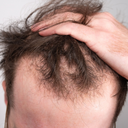Are you considering taking finasteride to combat hair loss, but wondering what kind of results you can expect?
You've come to the right place! In this article, we'll provide you with a comprehensive yet engaging overview of finasteride results, backed by research and data.
Plus, we'll sprinkle in a dash of humor to keep things light, because let's face it, no one wants to read a boring article about hair loss medication.
Table of content
What to expect for finasteride results?
Early results from Finasteride typically appear after 3 to 6 months of daily use. During this time, you may notice reduced hair loss or a stop in further thinning. Full results usually become visible after 6 to 12 months of consistent treatment.
Based on studies and user experiences, finasteride's impact on hair loss unfolds over time:
- 1-3 months: Possible initial hair shedding as a response to treatment.
- 3-6 months: Noticeable decrease in hair loss begins.
- 6-12 months: Research shows significant increases in hair count and a sustained reduction in hair loss after consistent one-year usage.
This is the average timeline, and it differs between users. Here is a more detailed breakdown of what happens in each milestone.
Month 1 to month 3
In the first three months of using finasteride, you may observe normal finasteride hair shedding, which is part of the regular hair growth cycle.
Month 3 to month 6
As you progress into the next three months, slow hair regrowth may become apparent, filling in bald patches.
Month 6 to month 12
Finasteride results after 6 months often demonstrate noticeable hair regrowth, filling in bald patches and improving overall hair density. Optimal results typically appearing after a year.
Month 12 onwards
Finasteride results after 2 years can show substantial hair growth, making it worth the wait for those dedicated to their hair loss treatment.
However, if no changes in hair growth occur even after a year, finasteride might not be working.
As your leading source for hair health information over the past 4 years, we never compromise on accuracy. When it comes to your health, you deserve information you can truly rely on - and earning your trust is our top priority.
Here's how Scandinavian Biolabs ensures every piece of content meets the highest standards of accuracy and integrity:
- Credentialed Experts: Our reviewers are actively practicing doctors and medical researchers
- Stringent Reviews: Content undergoes rigorous editing by subject specialists and review by a practicing doctor.
- Evidence-Based: We rely on well-established research from trusted scientific sources like peer-reviewed journals and health authorities.
- Full Transparency: Our editorial standards, writer credentials, reviewer credentials, correction process, and funding are all publicly documented.
- Independent Voice: While we do promote products, we operate in a vacuum to business operations. Our main goal is just an unwavering commitment to providing medically-sound guidance.
You can count on Scandinavian Biolabs to consistently deliver the trustworthy health information you deserve. Read our Editorial Standards.
Finasteride results before and after
These finasteride results before and after pictures hopefully will give you a more visual presentation of what to expect:



Research on finasteride results
One study evaluated the effectiveness of finasteride and dutasteride on hair loss in women with androgenetic alopecia over a period of 3 years and found that both medications showed a statistically significant increase in hair thickness from baseline over the 3-year period.
Another study evaluated the efficacy of oral finasteride therapy associated with an oral contraceptive containing drospirenone and ethinyl estradiol in premenopausal women with female pattern hair loss and found that 62% of the patients demonstrated some improvement of their hair loss with the use of finasteride.
A third study conducted in Switzerland found that oral finasteride 1 mg/day was effective in treating male pattern hair loss, with significant improvements observed in the photographs taken of the vertex and frontal areas.
Overall, the studies suggest that finasteride can be effective in treating hair loss in both men and women.
Topical vs oral Finasteride results
Many Finasteride users take oral tablets to combat hair loss, but topical Finasteride has emerged as a popular alternative for those wary of side effects. Studies show that topical Finasteride can be just as effective as the oral form in stimulating hair growth. The key advantage is that topical application offers lower systemic absorption, leading to reduced impact on serum DHT levels while still providing similar hair regrowth benefits.
How long does Finasteride take to work?
Finasteride typically takes 3-6 months to show initial results, with final improvements becoming visible around 6-12 months after starting treatment. Consistency is key, as the medication works gradually by adjusting hormone levels.
How long does Finasteride work for?
Finasteride will maintain your hair growth for as long as you consistently take it. It's safe for long-term use, but if you stop, hair loss will likely resume.
Is it too late to use Finasteride?
It's never too late to try Finasteride for hair regrowth. However, for extensive hair loss, a hair transplant may be necessary for more significant results. A trichologist can help you determine the best treatment for your condition.
How to maximize finasteride results?
To get the most out of your finasteride treatment, consider the following tips: Stick to the prescribed dosage (usually daily or every other day) – follow your doctor's instructions for best results.
Combine finasteride and minoxidil with other treatments, such as Scandinavian Biolabs' Hair Growth Routine, for a comprehensive approach to hair loss, aiming for healthy hair growth. Make lifestyle changes to support hair growth, like:
- Eating a balanced diet
- Managing stress
- Exercising regularly
- Be patient and consistent with your treatment to regrow hair and maintain its health
Rome wasn't built in a day, and neither is a full head of hair!
Potential side effects and risks
While finasteride is generally well-tolerated, it's important to be aware of potential side effects.
Common side effects include:
- Decreased libido
- Erectile dysfunction
- Ejaculation disorders
Rare but severe side effects may include:
- Breast tenderness or enlargement
- Depression
- Allergic reactions
Always consult with a healthcare professional before starting treatment and inform them of any existing medical conditions or medications you're taking.
What alternatives do you have to finasteride?
If finasteride results and side effects doesn't sound good to you,
Scandinavian Biolabs Hair Growth Routine: Our Hair Growth Routine is formulated with 100% plant-powered ingredients and is free of harmful chemicals. It promotes hair growth by nourishing and strengthening hair follicles while also assisting in preventing hair loss. Our customers have reported noticeable results within 150 days, and we offer a 150-day money-back guarantee if you're not satisfied with the results.
Minoxidil: This FDA-approved topical treatment is available over-the-counter and is known for promoting hair growth in individuals with thinning hair or pattern baldness. It is applied directly to the scalp and may show results within a few months of consistent use.
Low-level laser therapy (LLLT): LLLT uses red light to stimulate hair growth by increasing blood flow and cellular energy in the scalp. It is a non-invasive treatment option that can be administered through devices such as laser combs, caps, or helmets.
PRP (Platelet-Rich Plasma) therapy: This treatment involves injecting your own platelet-rich plasma into your scalp to stimulate hair growth. It's a more invasive option but has shown promising results for some individuals.
Natural remedies: Some people prefer to explore natural treatments for hair loss, such as essential oils, scalp massages, and herbal supplements. While these remedies might not be as potent as medical treatments, they can still provide some benefits.
Conclusion
Navigating the maze of hair loss solutions can be overwhelming, but understanding the efficacy and potential side effects of treatments like finasteride is crucial.
While it presents a promising avenue for many individuals with male pattern baldness, it's essential to weigh its benefits against potential risks. It's also worth exploring the myriad of alternative treatments available, from topical solutions to natural remedies.
Remember, every hair journey is unique. Equip yourself with knowledge, consult with professionals, and choose the path that aligns best with your needs and comfort.
FAQs
Can women use finasteride for hair loss?
Finasteride is not recommended for women, especially those who are pregnant or may become pregnant, due to the risk of birth defects. Women experiencing hair loss may consider other treatments, such as minoxidil for women or consulting with a dermatologist for alternative solutions.
How long does finasteride take to work and when does finasteride start working?
Depends on your body. Most users begin to see the initial effects within 3 to 6 months, with more substantial results after 12 months of consistent use.
Signs Propecia or finasteride is working may include reduced hair shedding, increased hair thickness, and the filling in of bald patches.
If you do not see results, consult a health professional who might increase the dosage, change your treatment to minoxidil or dutasteride.
Can I stop taking finasteride once I achieve my desired results?
Finasteride works to maintain and promote hair growth as long as you continue taking it. If you discontinue the treatment, you may experience a reversal of the positive effects, and hair loss may resume within several months. Additionally, you might experience finasteride side effects after stopping.
Reference:







